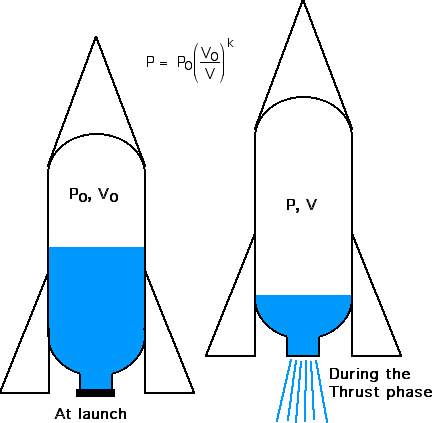- News & information
- About
- History
- George V. Voinovich
- George V. Voinovich Collection
- Calendar
- How to Find Us
- News
- Archives
- Photojournalism Fellowship Project
- Photo Essays
- Current Fellow
- Previous Fellows
- Reports and Publications
- Archives
- Students
- Prospective
- Center for Entrepreneurship
- Environmental Studies
- HTC/Voinovich School Scholars
- Master of Public Administration
- Current
- HTC/Voinovich School Scholars
- Center for Entrepreneurship
- Environmental Studies
- Master of Public Administration
- Alumni
- Contact
- School Leadership
- Strategic Partners Alliance
- Ohio University Public Affairs Advisory Committee
- Ohio University Public Affairs Advisory Committee
- Faculty and Fellows
- Faculty
- Visiting Professors
- Voinovich Fellows
- Professional Staff
Adiabatic Expansion Analysis
As the water escapes, the air volume decreases, causing a decrease in pressure and a corresponding decrease in thrust. We consider this process to be adiabatic (no transfer of heat during the split-second expansion process), which allows us to develop the equation for the variation of the pressure P to that of the volume V as presented in the following figure. The analysis that follows is adapted from the section on the Adiabatic Process of an Ideal Gas .
 We assume that the compressed air behaves as an
ideal gas throughout the process, and ignoring kinetic or potential
energy effects we consider the differential form of the energy
equation of a simple compressible system as follows:
We assume that the compressed air behaves as an
ideal gas throughout the process, and ignoring kinetic or potential
energy effects we consider the differential form of the energy
equation of a simple compressible system as follows:
d q - d w = d u
where:
d q = 0 is the heat transfered (equals zero for an adiabatic process). [Note also the use of the d (delta) operator indicating that heat and work are path functions, and not properties.]
d w = P d v is the specific boundary work done by the expanding compressed air [J/kg], and v is the specific volume of the air [m 3 /kg]. Note that V = m v , where m is the mass of the compressed air.
d u = Cv d T is the change of internal energy of the air, where Cv is the specific heat capacity at constant volume of the air [J/kg K], and T is the absolute temperature [K]
Thus P d v + Cv d T = 0
Differentiating the Ideal Gas Equation P v = R T ( R is the gas constant for air) we obtain:
P d v + v d P = R d T
We substitute this relation into the energy equation above to obtain
P d v (1 + Cv/R) + v d P (Cv/R) = 0
We now substitute the various relations concerning the Specific Heat Capacities of an Ideal Gas , including Cv + Cp = R and Cp/Cv = k , where Cp is the specific heat capacity at constant pressure [J/kg K] and k is simply known as the ratio of specific heat capacities. Simplifying and replacing V = m v we obtain:
k d V/V + d P/P = 0
This equation can be easily integrated (recall your calculus classes) leading to:
k ln (V/V0) = ln (P0/P)
where ln is the natural logarithm function, and the values of pressure and volume are those shown on the above figure.
Taking the inverse logarithm of this equation we obtain our required result:
Note that for any diatomic gas (such as O2, N2 - the major components of air) the value of k is 1.4
 Back
to Page 2 of the Water Rocket Analysis
Back
to Page 2 of the Water Rocket Analysis
 Adiabatic Expansion ... so that's
why Water
Rocket analysis is more complex than Space Shuttle analysis ...
Adiabatic Expansion ... so that's
why Water
Rocket analysis is more complex than Space Shuttle analysis ...

Engineering Thermodynamics
by Israel Urieli
is licensed under a Creative Commons Attribution-Noncommercial-Share
Alike 3.0 United States License
Contact Information:
(740) 593–9381 | Building 21, The Ridges
Ohio University Contact Information:
Ohio University | Athens OH 45701 | 740.593.1000 ADA Compliance | © 2018 Ohio University . All rights reserved.

